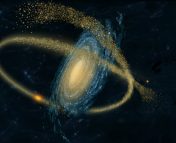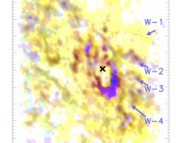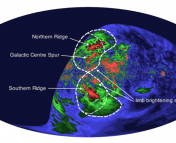The Undergraduate Research series is where we feature the research that you’re doing. If you are an undergraduate that took part in an REU or similar astro research project and would like to share this on Astrobites, please check out our submission page for more details. We would also love to hear about your more general research experience!

Emily Silich
University of Iowa
This guest post was written by Emily Silich. Emily is a 4th year undergraduate student at the University of Iowa studying astronomy, physics, and math. She began this research as a summer intern at NASA/GSFC, presented an overview of the project at AAS 237, and she will present the results for an undergraduate honors thesis this year. Her research mentors are Philip Kaaret (UIowa; HaloSat PI), Keith Jahoda (GSFC), and Lorella Angelini (GSFC).
X-ray observations of dark matter dominated objects, like galaxies and galaxy clusters, have detected a faint, unidentified X-ray emission line near 3.5 keV. After conventional astrophysical explanations for the line were determined to be physically unlikely, the 3.5 keV line has been controversially interpreted as a secondary product of a decaying dark matter particle, as discussed in this Astrobite. Specifically, while the nature of dark matter is still largely unknown, one dark matter particle candidate is the keV-scale sterile neutrino, which should spontaneously decay into an active neutrino and a photon with an energy of half the mass of the sterile neutrino. So, the decay of a sterile neutrino with a mass of ~7 keV should produce a photon with energy of 3.5 keV and could explain the 3.5 keV line feature.
This interpretation is controversial since multiple groups have used data from X-ray observatories like Chandra and XMM-Newton, with some reporting detections and others non-detections of the line, making them inconsistent with one another.
If the dark matter interpretation of the line is correct, there should exist a signal from the Milky Way’s dark matter halo that is correlated to the galaxy’s dark matter distribution. HaloSat is an X-ray CubeSat mission that was designed primarily to study diffuse ~0.6 keV emission expected in the diffuse halo of the Milky Way galaxy. Due to HaloSat’s large field of view (~100 deg2), CCD-like energy resolution, and relatively simple background above 2 keV, HaloSat observations of diffuse emission from the Milky Way have comparable sensitivity to observatories like Chandra and XMM-Newton, while providing observations with systematics that are different than those associated with the CCD instruments. We use data from HaloSat to search for the presence of the 3.5 keV line in the Milky Way’s dark matter halo and test the decaying dark matter particle interpretation of the line.

We obtained HaloSat observations near the Galactic Center, where dark matter is most concentrated and the expected 3.5 keV signal is strongest, while avoiding bright X-ray sources that would contaminate the diffuse emission. Observations were collected from May 2019 to July 2020. We analyzed the spectra from our observations using X-ray spectral fitting software, and modeled all background contributions in each observation. Each observation has contributions from HaloSat’s instrumental background as well as the astrophysical background, which includes unresolved extragalactic X-ray sources (known as the Cosmic X-ray Background) and any unavoidable bright X-ray point sources in the fields. After modeling the background, we investigated the presence of a line at 3.5 keV. Some previous searches for the line in the Milky Way have reported detections of a line at a significance of ~2σ or greater, however we did not see evidence of a line at this strength, and so we estimated upper limits on the flux of the 3.5 keV line in each observation.
A physically interesting property of the sterile neutrino is the mixing angle, which is a parameter in our theory of particle interactions that describes the strength of the coupling between sterile and active neutrinos. A stronger coupling means that the sterile neutrinos decay faster, which results in a stronger 3.5 keV line. So, we translated our flux upper limits to constraints on the mixing angle for the 7 keV sterile neutrino. Our future work includes performing an analysis of our limits to make a statistically robust statement about the decaying dark matter particle interpretation of the 3.5 keV line.

Astrobite edited by: Emma Foxell




